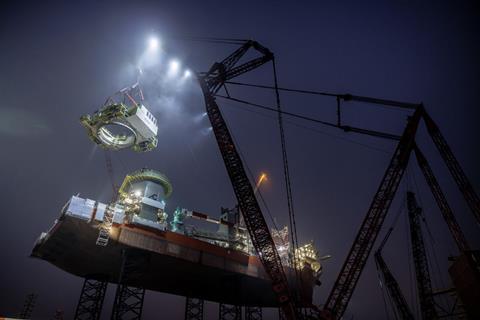Heavy lift specialist Mammoet utilised its PTC210-DS ring crane to replace the leg cranes on Cadeler’s wind farm installation jack-up vessels Wind Orca and Wind Osprey on behalf of GustoMSC.

Cadeler replaced the cranes to handle the next generation of wind turbines and their components, with the units now offering a lifting capacity of 1,600 tonnes.
For Mammoet, the project required one of the largest cranes in its fleet, the PTC210-DS, with the work taking place at its yard in Schiedam, the Netherlands. Dirk Knoester, senior adviser at Mammoet, said: “The PTC210-DS is the perfect crane for this job. It has a relatively small footprint combined with 360-degree slewing, with the possibility to switch between fixed and luffing jib mode (as only the PTCs can) resulting in the largest possible working area.
“PTC cranes can also be assembled in numerous configurations and thus a tailor-made configuration is feasible for any job: different main boom and jib lengths, fixed or luffing jib, different amounts of counterweight and two ring diameters.”
These attributes made it an ideal crane for this project, where jack-up vessels were to be positioned on either side of Mammoet’s quay, which has a peninsula configuration. This allowed two vessels to be worked on together.
With Wind Orca and Wind Osprey moored on opposite sides of the quay, the PTC210-DS could be positioned in the centre, slotted between both vessels.
The new leg cranes comprised four main sections that needed to be installed: the pedestal, the rotating platform, the A-frame and the 149 m-long main boom. To enhance stability and control during the main boom lifts, an LR1800-1.0 crawler crane was used as an assist crane. Working together, the PTC210-DS lifted one end of the boom as the crawler crane lifted the other.
Performing this operation on a busy quay was a challenge that required effective space management. Mammoet’s Schiedam location serves many active projects in Belgium and the Netherlands on a daily basis. The site had to serve as a temporary laydown area for all components being added to the Wind Orca and Wind Osprey, including the large booms.
Work on Wind Orca and Wind Osprey will continue this year, with completion anticipated later in 2024.
















